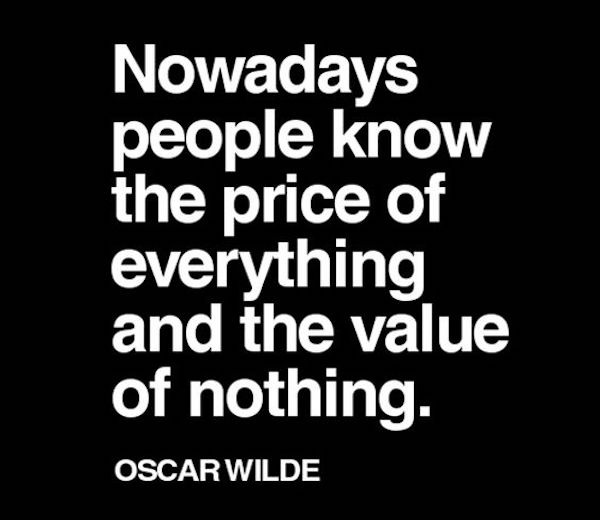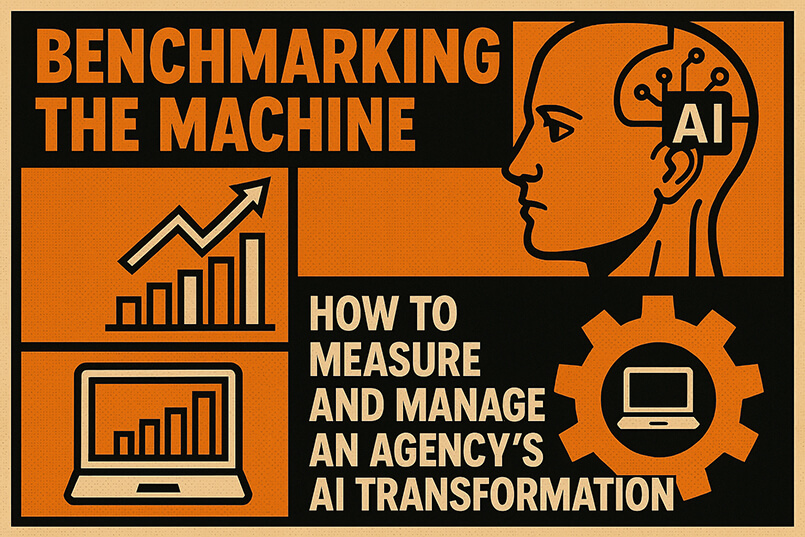In response to the question of “What is a cynic?” Oscar Wilde wrote “A man who knows the price of everything and the value of nothing”. When it comes to agency benchmarking it is hard not to be cynical.
How do we stop the manslaughter and increase agency productivity and performance? The first step is to stop cost benchmarking and move the focus to performance. Here is why.
What is Agency Benchmarking?
The majority of what passes for agency benchmarking is simply cost benchmarking. The focus on agency salaries and the elements that are used to calculate the effective charge out rate such as overhead, profit multiple and billable hours per annum are simply required to validate the cost charged by the agency per hour or day or as part of a retainer per resource or full time equivalent (FTE).
This type of cost benchmarking is applied primarily to the agency resources and the services billed to the client and are typically defined only by role and service type, without consideration of quantity and quality. We offer this service on-line through our Ad Cost Checker website as it is a relatively simple methodology reliant on a sample or pool of data that is statistically significant to represent the market being benchmarked.
But even then Ad Cost Checker goes one step further than most cost benchmarking practices in that it recognises that resource cost is not job title dependent alone. In fact the size and ownership of the agency and the size and type of the client or advertiser, plus the relationship between the two also impacts on the benchmark. e.g. A network agency will charge a different fee to a local independent advertiser for the same advertiser client. This is because they have different cost bases and often very different business strategies regarding new business development.
The underlying assumption with classic cost benchmarking is that the resources or services being benchmarked are either consistent in quality or commodities in nature to allow the like-for-like comparison. But when it comes to agency resources, the assumption that the job title defines the quality of that resource is flawed.
Where is the value in cost benchmarking?
If advertising is a people business and cost benchmarking is about determining the cost of the various people supplied by the agency to work on the advertisers business then the value is in the people or human resources. But there are many reasons why job titles or job descriptions do not define the quality of the resource being purchased or benchmarked. Therefore the concept of benchmarking agency value being the cost of the resources against the quality of that resource is flawed.
- There is no industry standard regarding job titles and their expertise, experience or capabilities. While titles such as Account Co-ordinator, Account Manager, Account Director etc are standard, they are applied on an ad-hoc basis across the industry and do not necessarily reflect a common level of expertise. Therefore a Group Account Director in a small agency could be very different in experience, expertise, capabilities and cost, to a Group Account Director in a large multinational agency.
- The application of digital technology into the advertising mix has disrupted the job titles within agencies and lead to the growth of new and different job titles and descriptions within agencies making like-for-like difficult. In the past few years we have seen great creativity in job titles such as Director of Storytelling, Wizard of Light Bulb Moments, etc. It is interesting trying to meaningfully benchmark any one of these.
- As advertisers are paying on salaries or at least declared salaries, some agencies have perfected the practice of providing staff with a title promotion, without the corresponding increase in salary. This is particularly effective in markets where perception is more important than reality and so the advertiser pays for the title but does not get the quality, just as the agency resource gets the title but not the salary.
So if you are not consistently or realistically benchmarking the quality of the agency resources where is the value in this cost benchmarking? If you buy your books by the kilo then this is a great way to drive down cost, but at what cost to the agency and ultimately to the advertiser? Michael Farmer has demonstrated the impact on both agency and advertiser and now calls on all parties to stop the Madison Avenue Manslaughter and return to productive, sustainable relationships and encourage performance and growth.
The short-comings of cost benchmarking
Beyond the fact that cost benchmarking is not just flawed but has had a catastrophic impact on industry performance, it also does not deliver a view of the value of the agency work. After all the reason an advertiser engages an agency is ultimately not to retain a collection of advertising specialists, but to have that collective produce outputs that will deliver specific outcomes required of their marketing communications strategy.
So how does cost benchmarking of the agency resources deliver a benchmark of their ability and value in producing either those outputs (such as advertising) or outcomes (such as specific and measurable results)? It doesn’t. But some would argue that they can use this cost benchmarking to calculate what resource would be required to produce specific advertising outputs. We do this work and have been for more than 15 years using our scope of work calculator.
Based on the scope of work, the specific outputs required, we are able to accurately calculate the agency resources required. Not just the level of resources, but the mix by discipline and seniority. These are benchmarks that are not often asked for as most people are only aware of cost benchmarks. But they add the value dimension as it allows us to calculate the value of the agency outputs, which is the basis of the value based remuneration model.
Defining agency value
So how do we benchmark the value of the agency outputs and the outcomes they deliver. Lets think about outputs first as these are easier. The outputs of the agency are the work they do and collectively are the scope of work. To benchmark an agency without some type of output measure reduces the results to cost based benchmarking only.
Therefore the outputs are essential as part of any value study. This could be the collective outputs for a year making an annual agency scope of work, or they could be individual projects made up of incremental deliverables to actual individual deliverables, such as a television commercial to a corporate video to a Facebook post. What makes a deliverable is the ability to define the output, both tangible and intangible.
Here is where benchmarking becomes valuable and overcomes the shortcomings of cost benchmarking alone. Using the resource benchmarks mentioned previously we are able to calculate the resource requirements and therefore able to benchmark the productivity of the agency, in a very similar approach to the Farmer Scope Measurement Units (SMU™).
Instead of simply benchmarking cost we are able to assess the efficiency and productivity of the agency. This becomes the basis of value based remuneration, where a value is placed on those agency deliverables using benchmarking to define the commercial value of those deliverables.
The benchmarking of the outcomes the agency contributes to, depends on the advertisers having not just specific and relevant performance metrics, aligned to the agency outcomes, but the monitoring of those outcomes. These metrics can be media metrics, advertising metrics, marketing metrics or business metrics, or a combination of any of the same.
This performance-based remuneration is designed to incentivise the agency to work towards delivering specific performance metrics and rewarding them for their contribution to that success. It is just unfortunate that performance based remuneration has earned such a poor reputation due to the misuse of this approach to reduce agency fees rather then incentivise performance.
Defining business value
In recent years, with more organisations applying Zero Based Budgeting (ZBB) to their marketing budgets, there has been a renewed interest in Value Based Remuneration and with a particular focus on aligning the value of the agency outputs to the marketing value and the financial value to the business.
This is where Value Based Remuneration is particularly useful as the valuation of the work outputs of the agency go beyond the agency value to reflect the value to the business. Let me explain. Under the cost input model currently in place, the resources required to make a particular output, say a Television Commercial are the same no matter the value to the marketers or the organisation.
It can be argued that it takes the same number of people and hours to conceive and produce a big brand television commercial for a major high value brand as it does to do the same for a lesser value brand. Under the Value Based Remuneration model the value of the big brand ad would be higher than the value of the smaller brand ad and would attract a higher budget and greater media support, therefore the value paid to the agency would be higher than the amount paid to the agency for the smaller brand ad.
What this means is that much like the ZBB approach, for a house of brands you are able to remunerate the agency not based on the cost of the work by the agency, but on the value this work represents to the brand, the marketing and the organisation. It allows marketers to invest more in the brands where the business case justifies the high level of investment and to invest less in the brands that have lesser value.
Even in a branded house, where there is only one brand, you are able to value the work outputs by the streams of work such as:
- long-term brand and business building,
- product and service promotion and
- agile marketing or acquisition work.
In this case the valuation is adjusted based on the perceived time in market of the particular execution.
No matter the approach we are able to benchmark and assess the value, starting with the underlying cost as a starting point, but then providing a methodology to achieve the valuation specific to the agency outputs and ultimately the contribution to business outcomes. This is very different and more insightful than simply cost benchmarking provided generally by the industry.
Benchmark cost or benchmark value?
As Michael Farmer recently wrote, cost benchmarking turns all those involved into losers. Simply delivering lower costs results in cheaper resources and undermines the value of the agency in delivering value to the advertiser.
But value based benchmarking is possible, although not common, and this provides insights into how to value the work of the agency. This value is not just the value of the agency work, but in a time when Zero Based Budgeting is increasingly popular, a value to the business for the deliverables of the agency. Although ultimately the true value of the agency is measured in the outcomes of those agency deliverables and the impact they have on business value through marketing performance.
This is the work we have been doing with out clients and in those cases we are able to move benchmarking from a cost focus to a value focus, the result is increased performance and greater value for all involved.
The choice therefore is either win with value or lose with cost. So in the words of Oscar Wilde are you a cynic or not?
TrinityP3’s Scope of Work Management service evaluates your current agency scope of work and recommends the best approach, calibrated to your needs and benchmarked against the industry.
Why do you need this service? Learn more here




